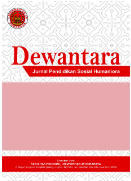Uang Dan Sistem Keuangan
DOI:
https://doi.org/10.30640/dewantara.v3i2.2629Keywords:
Money, System, FinanceAbstract
Something that is generally accepted to pay debts, buy goods and services, and pay for general needs is called money. However, a financial system is a collection of financial markets, financial service institutions, and financial infrastructure, including payment systems. They work together to facilitate the collection and allocation of funds to support national economic activities, as well as to companies and households connected to financial services institutions. How the monetary sector influences the stability of the Indonesian financial system is the subject of this research. with the problem formulation: 1) Understanding the function of money and, 2) Australian financial system, 3) Money circulation, 4) Money demand, and 5) Balance. The findings show that exchange rates, exchange rates and inflation can influence the stability of the financial system. The literature method was used in this research, which includes library research and secondary data obtained from the Indonesian Statistics Center. The results are very important for explaining how financial system stability is influenced by the monetary sector and how financial system stability affects Indonesia's economic growth.
References
Adhista. (2022). Analisis ekspor, impor, dan jumlah uang beredar (M2) terhadap nilai tukar rupiah. Jurnal Ilmiah Ekonomi Pembangunan, 1(2), 74-75.
Agusmianata, Militina, & Lestari. (2017). Pengaruh jumlah uang beredar dan tingkat suku bunga serta pengeluaran pemerintah terhadap inflasi di Indonesia. Forum Ekonomi, 189-190.
Choudhary, R., Mathur, S., & Wallis, P. (2023). Leverage, liquidity and non-bank financial institutions: Key lessons from recent market events.
Docherty, P., & Wang, G. (2020). Menggunakan data sintesis untuk mengevaluasi dampak RTGS terhadap resiko sistemik dalam sistem pembayaran Australia. Jurnal Stabilitas Keuangan, 6(2), 103-117.
Gazali, D. S., & Usman, R. (2010). Hukum perbankan. Jakarta: Sinar Grafika.
Irwansyah, Muhammad Subhan, & Rabiyatul Alawiyah. (2019). Analisis faktor-faktor yang mempengaruhi yang mempengaruhi profitabilitas. Jurnal Akuntansi dan Keuangan, 2(2), 40-57.
Khoerul Ummah. (2022). Analisis permintaan uang pada masyarakat Islam kontemporer. Jurnal Riset Ekonomi, 2(8.5.2017), 2003-2005.
Kholis, N. (2017). Potret perkembangan dan praktik keuangan Islam di dunia. Millah: Jurnal Studi Agama, 17(1), 24.
Laila, N. N. (2020). Hubungan luar negeri Australia dengan negara-negara Pasifik dalam bidang ekonomi periode 2012-2018. Khazanah Sosial, 2(2), 78-87.
Muflihin. (2019). Permintaan, penawaran dan keseimbangan harga dalam perspektif ekonomi mikro Islam. Jurnal Ekonomi Syariah, 185-195.
Salsabila, N., & Giri, R. R. W. (2017). Peta positioning uang elektronik berdasarkan persepsi masyarakat di Indonesia tahun 2017. Jurnal Riset Bisnis dan Manajemen (JRBM), 10(2), 34-41.
Soemitra, A. (2009). Bank dan lembaga keuangan syariah. Jakarta: Kencana.
Zulkifli Hasibuan, M., et al. (2022). A brief history of financial system and the birth of money. Universitas Muslim Nusantara Al Washliyah, 3(1), 259-260.
Downloads
Published
How to Cite
Issue
Section
License
Copyright (c) 2024 Dewantara : Jurnal Pendidikan Sosial Humaniora

This work is licensed under a Creative Commons Attribution-ShareAlike 4.0 International License.








